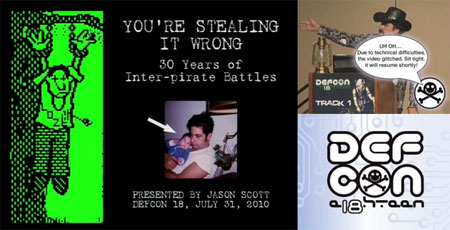
[Jason Scott], data historian extraordinaire gave this fantastic speech at Defcon 18 about the history of inter-pirate piracy. At an hour long, it is an enthralling journey through computer history, especially pertaining to piracy. Take a seat, no matter how much you know about security and piracy, you are likely to learn a few things. We find the lesser discussed issues like pirates stealing other pirates work interesting, as well as the part where pirates have to crack really boring software to have a release when there’s nothing better out there. Also worth noting, according to [Jason], the demoscene evolved from the little opening sequences from cracks. There are just too many interesting aspects to note here, even some porn related stories during the BBS days.
This is a great lesson from someone who is both knowledgeable and entertaining. [Jason] teaches this stuff without ever sounding stuffy, boring, or overly technical. Catch the video after the break.
Continue reading “You’re Stealing It Wrong: A Speech By Jason Scott”















